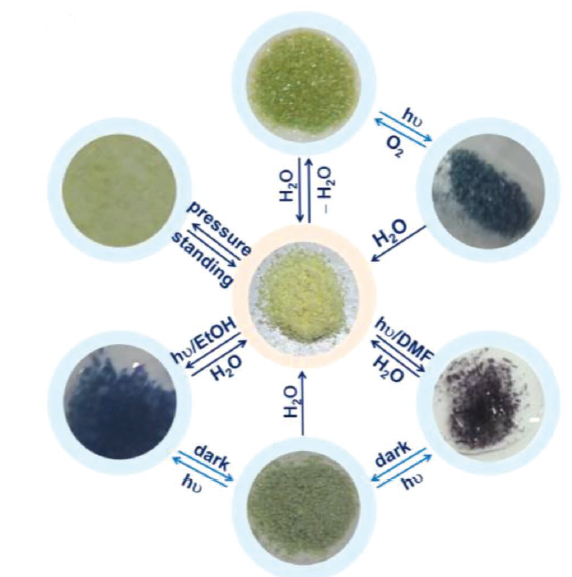Multiple and reversible responses in viologen based MOF - Dr. Lin Wang
FEBRUARY 15, 2019
It is challenging to mobilize as many properties as possible to one metal-organic frameworks — MOF to realize multiple responsive properties. New work from a team of scientists including Dr. Lin Wang of HPSTAR found that a newly synthesized viologen-based MOF could assembly versatile and switchable responsive properties. The work is published in recent issue of Small.
'Metal-organic frameworks' (MOFs) are porous, crystalline polymers made of metal nodes linked by organic ligands. The pores in their molecular structure allow MOFs to capture molecules. Its unique crystal structure also makes it as promising platforms for the design of responsive materials. The hybrid crystalline networks can in principle be imparted with various responsive properties through functionalizing the metal-based joints, the organic linkers, and the pore space or utilizing the cooperative effects between these components.
Viologen will change colors through forming cationic radicals by electron transfer under various stimuli, such as light/photo or pressure, which are called photochromism and piezochromism, respectively. Considering the versatile responsive capabilities of viologen, people presume that the viologe-based MOF is also potentially responsive to various stimuli such as light and pressure.
For the viologen-based MOFs, permanent pores and stable structure is necessary to make sure the MOF framework not collapse after external stimuli.
 The team recently sythesized a unique lanthanideviologen ionic MOF (named LVMOF-1), the viologen serves as the organic crosslinkers in the three dimentional MOF structure. The LVMOF-1 sythesized by the team exhibits permanent open channels and excellent chemical tolerance in various media including wate. This makes LVMOF-1 ideal for responsive study and practical modulation applications.
The team recently sythesized a unique lanthanideviologen ionic MOF (named LVMOF-1), the viologen serves as the organic crosslinkers in the three dimentional MOF structure. The LVMOF-1 sythesized by the team exhibits permanent open channels and excellent chemical tolerance in various media including wate. This makes LVMOF-1 ideal for responsive study and practical modulation applications.
They found that this LVMOF could mobilize multiple responsive properties. What’s more it’s the first MOF material showing colour change due to pressure—the so-called piezohchromism.
Like violgen, LVMOF-1 with Cl-/Br- ions changes color in response to a variety of stimuli. First, it shows reversible color change upon water release and reuptake—hydrochromism.
They also found that the orginal LVMOF-1 is not photochromic but release of guest water or immersing in different organic solvents would lead to electro transfer and thus radical formation and finally photochromism. This suggests that the photochromic phenomenon for the MOF is indirectly. “Actually, the guest water/solvent molecules are not donors but a kind of stumulus factor in electron transfer—water molecules that impede electron transfer are replaced by other solvent molecules, which have weaker or no polarity and hydrogen-bonding ability”, explained Dr. Lin Wang, a co-author of the present work.
They further verified that the electron donor Cl− or Br− ions. “During the hydrochromism or photochromism, the water molecules/anion exchange act as flexible handle to impede forward ET from chloride to viologen and promote back ET”, explained in the paper. “The effects of water are similar to those we have recently found in viologen”, added by Dr. Lin Wang.
LVMOF-1-Cl is also piezochromic. The pale yellow sample turns green after compression. However, if kept at ambient pressure for hours, the green sample completely returns to the original yellow color. “LVMOF-1 represents the first example of piezochromism in MOF, stated in the paper.
Besides radical formation from electron transfer, charge transfer complex from selective anion exchange in the MOF will also lead to colour change—the pale yellow MOF will turn to orange if iodide ion exchange with Cl- to form iodide-viologen charge transfer complexation. While the LVMOF-1 with iodide ion does not have any response to water, light or pressure. This suggests that the charge transfer complexation will suppress electron transfer and thus the related responsiveness. They also found the radical formed from electron transfer or chare transfer complexation in the MOF will switch off the Eu luminescence through energy transfer from Eu to radicals or charge transfer complex.
“The stability of the material against stimuli and the reversibility of the chromogenic phenomena are very important for many applications such as switches and sensors. To our satisfaction, the crystalline framework is retained after exposure to all abovementioned stimuli, and all of the abovementioned chromogenic processes are reversible”, stated in the paper.
The work illustrates that viologen-based ionic MOFs are powerful platforms to manipulate responsive properties which will also lead to new responsive materials.
Caption: Photographic images showing the reversible color changes of polycrystalline samples in response to various physical and chemical stimuli.
金属有机骨架材料(Metal-Organic Frameworks, 简称MOFs)以其高的空隙率,可调节性,及可修饰性而受到广泛关注。由于MOF材料的可修饰性,近年来长常被用来设计合成具有响应性能的功能材料。北京高压科学研究中心的王霖研究员参与的研究小组在最新合成的紫精类的MOF材料中实现了多重可逆的响应—水致变色,光致变色。并且首次在MOF中发现了压致变色的现象。这些变色现象与他们最近在紫精类材料中发现的一致。在这些响应中也涉及到了电子的转移而导致的变色自由基的形成。并且他们发现由于阴离子交换而产生的电荷转移配合物也会使得MOF表现出变色响应。他们得出水分子及客体阴离子在电子转移引起的响应中起到了有效的调节作用而非电子的供体。另外可逆的阴离子交换作用会抑制电子转移以及由此而产生的响应现象。MOF材料所表现出的多重响应性能使得它在压力传感器,碘化物的检测等方面具有很好的应用前景。
